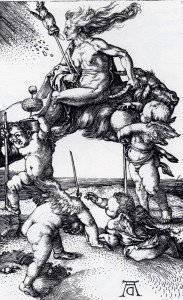Edward Burne-Jones: The Last Sleep of Arthur, 1881–1898
When we look at some of the most popular pieces of fiction in the English language we find that most of them contain a little bit of supernatural. From the ever popular plays of Shakespeare to the newest young adult fiction witches are guaranteed to pop up somewhere in the mix. They fulfil various roles in literature, sometimes they are the personification of fate, and sometimes they form an entire society paralleling our own and exposing our prejudices. Even though their powers seem to be quiet varied, most interpretations rely on some aspects of the rich folklore surrounding witchcraft.
The folkloric image of the witch seems to be present in centuries old legal and church documents too. Even the king of England, James I of England wrote a lengthy document, titled Daemonologie, In Forme of a Dialogie, Divided into three Bookes. By James Rx, about the most important characteristics of witches and this document clearly suggests the practice of witchcraft was perceived to be real. Some of these characteristics of witches were the presence of an animal companion, a close relationship with the devil, and most importantly the claims of victims who said they were cursed by the witch.
 But the early image of the witches was radically different from their popularized one. Early medieval church documents reveal that most people accused of witchcraft committed minor sins. Some of the suspects were priest, who used information gathered through confession to find lost properties, or healers who used the combination of herbs and prayer to cure the sick. These offences were not severely punished by the church and even the gender distribution seemed to be equal compared to later witch hunts. But at the beginning of the Early Modern era witchcraft started to have a different meaning and it became a severely punishable heresy.
But the early image of the witches was radically different from their popularized one. Early medieval church documents reveal that most people accused of witchcraft committed minor sins. Some of the suspects were priest, who used information gathered through confession to find lost properties, or healers who used the combination of herbs and prayer to cure the sick. These offences were not severely punished by the church and even the gender distribution seemed to be equal compared to later witch hunts. But at the beginning of the Early Modern era witchcraft started to have a different meaning and it became a severely punishable heresy.
Just like in real life, the change in the figure of the witch is also noticeable in literature. The earliest appearances of the famous witch Morgan le Fay of the Arthurian legends cast her in a much more ambiguous role than her better known appearances in later romances. In Geoffrey of Monmouth’s Vita Merlini she is a healer of the Island of Avalon where King Arthur is treated for his injuries. But in later fiction she appears as the antagonist of the stories. In Sir Thomas Mallory’s Le Morte D’Arthur she is clearly the evil witch, we all know, who is determined to wreck havoc and ruin Arthur. The shift in the image of Morgan le Fay and the change in the church’s interpretation of witchcraft are paralleled and it is my intention to closely examine this interpretative shift.
Albrecht Dürer: Witch Riding Backwards On A Goat, circa 1500
Sources of images: https://en.wikipedia.org/wiki/Witchcraft
https://en.wikipedia.org/wiki/The_Last_Sleep_of_Arthur_in_Avalon


great article, nice to read u’r post, thank you for sharing